Examining Congruence and Semantic Relatedness within Stroop Effect
VerifiedAdded on 2023/06/10
|12
|3110
|458
Report
AI Summary
This report investigates the Stroop effect, specifically examining the impact of congruence and semantic relatedness on task completion time. The study involved 32 undergraduate students who participated in three experimental sets: identifying colors, responding to incongruent color-word stimuli, and responding to congruent stimuli. The hypothesis that task completion time would be longer for incongruent and semantically unrelated conditions compared to congruent conditions was supported by the findings. The results indicated that participants took longer to respond to incongruent stimuli when asked to disregard the text meaning and name the ink color. The discussion integrates theories such as speed processing and selective attention to explain the observed effects, concluding that color naming requires more attentional effort due to incongruence, thus increasing task completion time. The report also touches upon the role of automaticity in reading and its interference with color naming, contributing to a deeper understanding of cognitive processes involved in the Stroop effect. Desklib provides access to this and many other solved assignments.
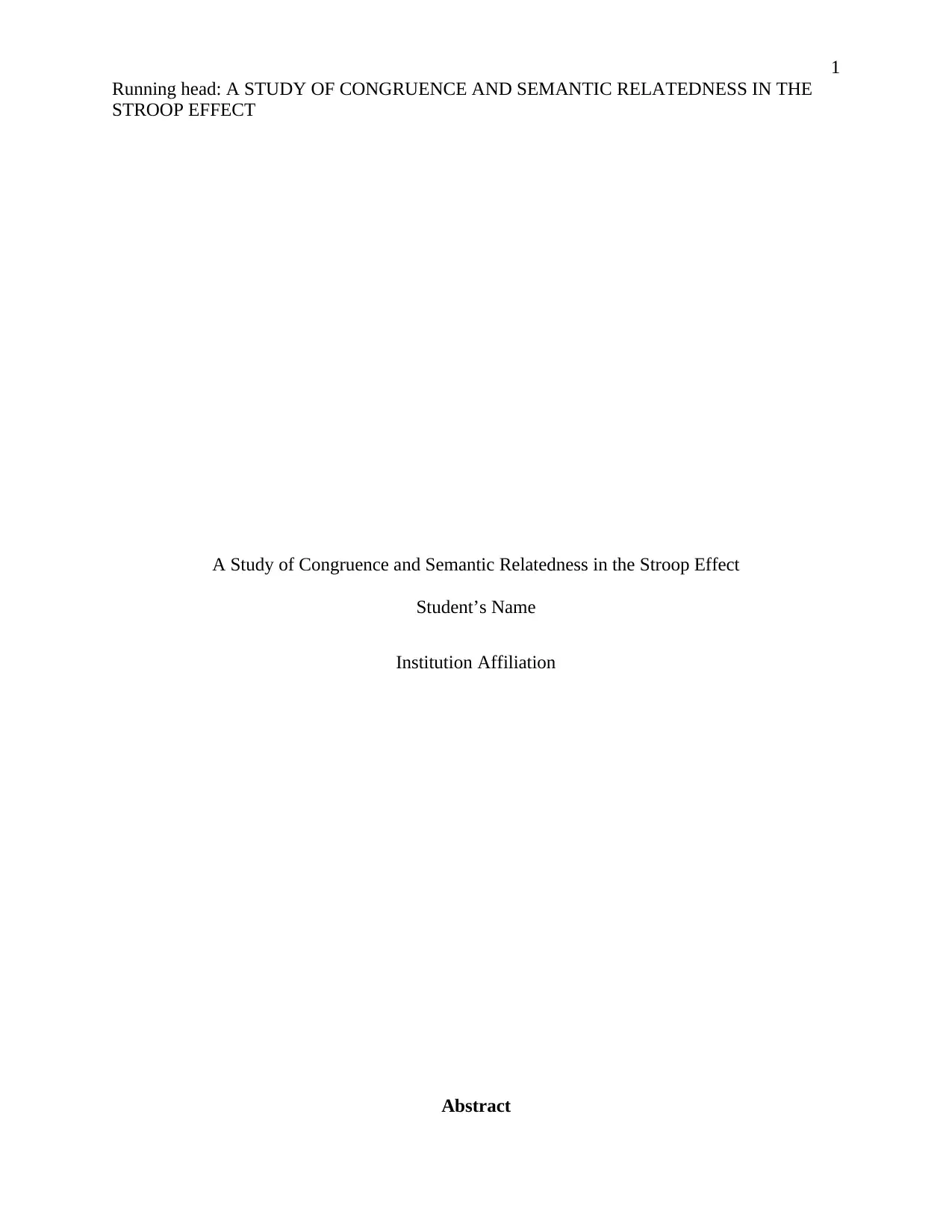
1
Running head: A STUDY OF CONGRUENCE AND SEMANTIC RELATEDNESS IN THE
STROOP EFFECT
A Study of Congruence and Semantic Relatedness in the Stroop Effect
Student’s Name
Institution Affiliation
Abstract
Running head: A STUDY OF CONGRUENCE AND SEMANTIC RELATEDNESS IN THE
STROOP EFFECT
A Study of Congruence and Semantic Relatedness in the Stroop Effect
Student’s Name
Institution Affiliation
Abstract
Paraphrase This Document
Need a fresh take? Get an instant paraphrase of this document with our AI Paraphraser
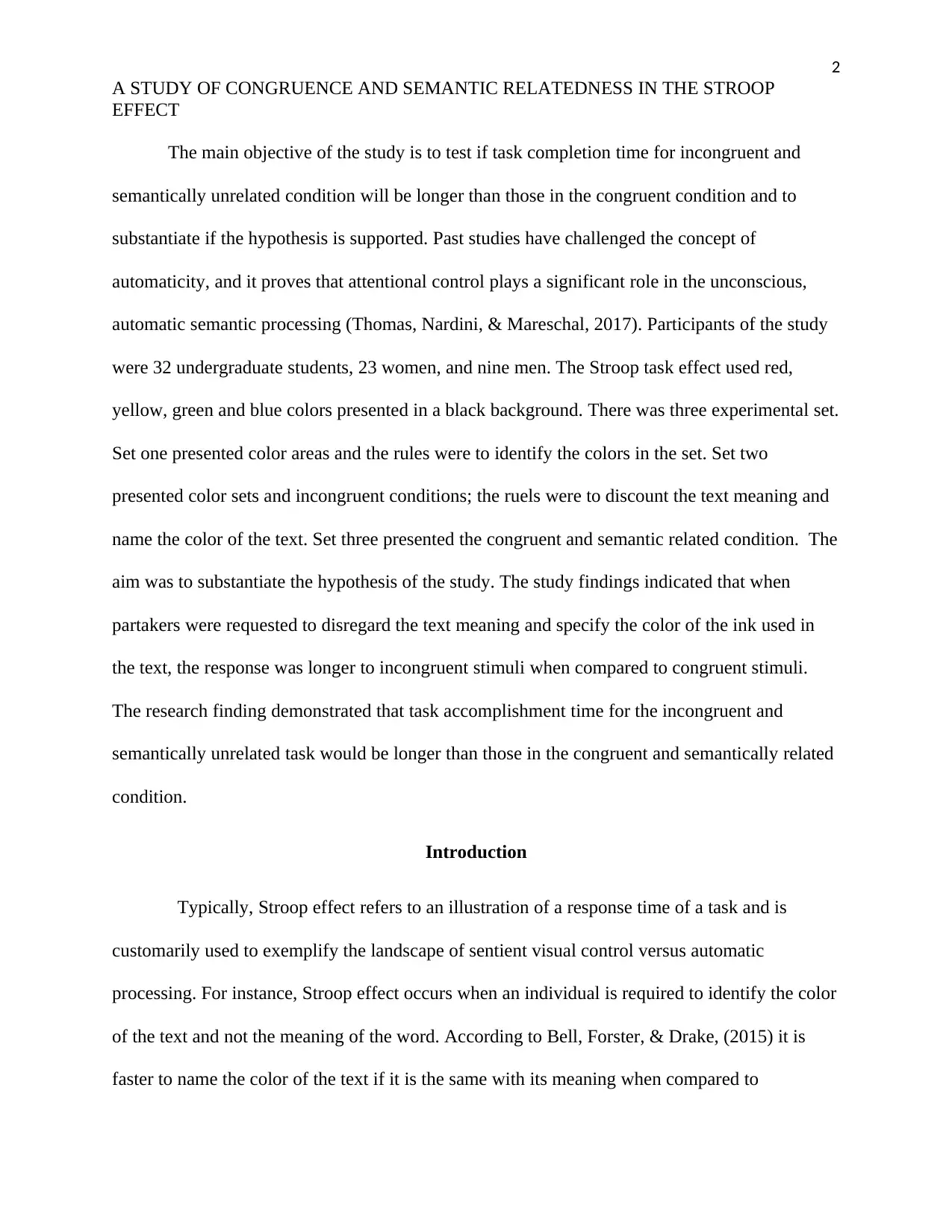
2
A STUDY OF CONGRUENCE AND SEMANTIC RELATEDNESS IN THE STROOP
EFFECT
The main objective of the study is to test if task completion time for incongruent and
semantically unrelated condition will be longer than those in the congruent condition and to
substantiate if the hypothesis is supported. Past studies have challenged the concept of
automaticity, and it proves that attentional control plays a significant role in the unconscious,
automatic semantic processing (Thomas, Nardini, & Mareschal, 2017). Participants of the study
were 32 undergraduate students, 23 women, and nine men. The Stroop task effect used red,
yellow, green and blue colors presented in a black background. There was three experimental set.
Set one presented color areas and the rules were to identify the colors in the set. Set two
presented color sets and incongruent conditions; the ruels were to discount the text meaning and
name the color of the text. Set three presented the congruent and semantic related condition. The
aim was to substantiate the hypothesis of the study. The study findings indicated that when
partakers were requested to disregard the text meaning and specify the color of the ink used in
the text, the response was longer to incongruent stimuli when compared to congruent stimuli.
The research finding demonstrated that task accomplishment time for the incongruent and
semantically unrelated task would be longer than those in the congruent and semantically related
condition.
Introduction
Typically, Stroop effect refers to an illustration of a response time of a task and is
customarily used to exemplify the landscape of sentient visual control versus automatic
processing. For instance, Stroop effect occurs when an individual is required to identify the color
of the text and not the meaning of the word. According to Bell, Forster, & Drake, (2015) it is
faster to name the color of the text if it is the same with its meaning when compared to
A STUDY OF CONGRUENCE AND SEMANTIC RELATEDNESS IN THE STROOP
EFFECT
The main objective of the study is to test if task completion time for incongruent and
semantically unrelated condition will be longer than those in the congruent condition and to
substantiate if the hypothesis is supported. Past studies have challenged the concept of
automaticity, and it proves that attentional control plays a significant role in the unconscious,
automatic semantic processing (Thomas, Nardini, & Mareschal, 2017). Participants of the study
were 32 undergraduate students, 23 women, and nine men. The Stroop task effect used red,
yellow, green and blue colors presented in a black background. There was three experimental set.
Set one presented color areas and the rules were to identify the colors in the set. Set two
presented color sets and incongruent conditions; the ruels were to discount the text meaning and
name the color of the text. Set three presented the congruent and semantic related condition. The
aim was to substantiate the hypothesis of the study. The study findings indicated that when
partakers were requested to disregard the text meaning and specify the color of the ink used in
the text, the response was longer to incongruent stimuli when compared to congruent stimuli.
The research finding demonstrated that task accomplishment time for the incongruent and
semantically unrelated task would be longer than those in the congruent and semantically related
condition.
Introduction
Typically, Stroop effect refers to an illustration of a response time of a task and is
customarily used to exemplify the landscape of sentient visual control versus automatic
processing. For instance, Stroop effect occurs when an individual is required to identify the color
of the text and not the meaning of the word. According to Bell, Forster, & Drake, (2015) it is
faster to name the color of the text if it is the same with its meaning when compared to
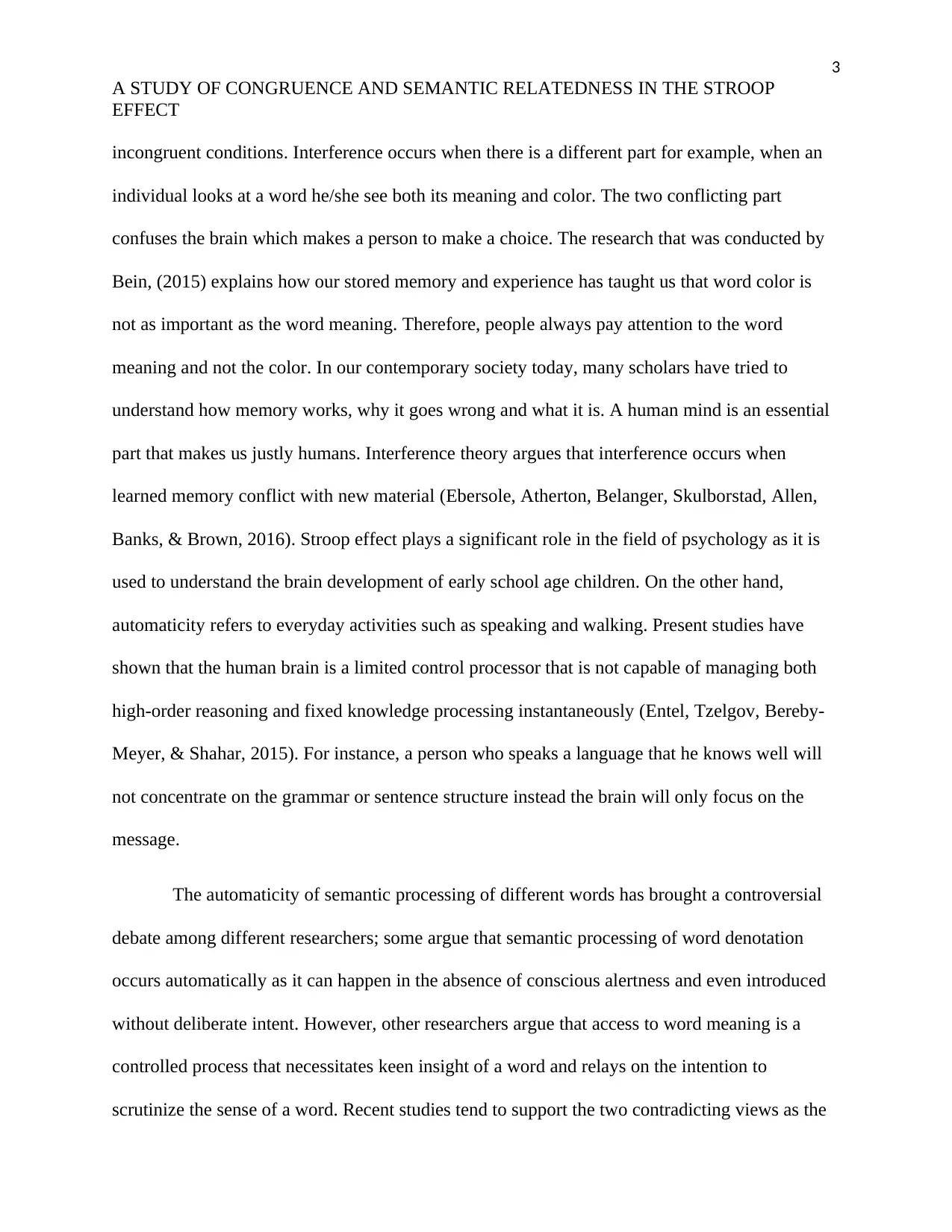
3
A STUDY OF CONGRUENCE AND SEMANTIC RELATEDNESS IN THE STROOP
EFFECT
incongruent conditions. Interference occurs when there is a different part for example, when an
individual looks at a word he/she see both its meaning and color. The two conflicting part
confuses the brain which makes a person to make a choice. The research that was conducted by
Bein, (2015) explains how our stored memory and experience has taught us that word color is
not as important as the word meaning. Therefore, people always pay attention to the word
meaning and not the color. In our contemporary society today, many scholars have tried to
understand how memory works, why it goes wrong and what it is. A human mind is an essential
part that makes us justly humans. Interference theory argues that interference occurs when
learned memory conflict with new material (Ebersole, Atherton, Belanger, Skulborstad, Allen,
Banks, & Brown, 2016). Stroop effect plays a significant role in the field of psychology as it is
used to understand the brain development of early school age children. On the other hand,
automaticity refers to everyday activities such as speaking and walking. Present studies have
shown that the human brain is a limited control processor that is not capable of managing both
high-order reasoning and fixed knowledge processing instantaneously (Entel, Tzelgov, Bereby-
Meyer, & Shahar, 2015). For instance, a person who speaks a language that he knows well will
not concentrate on the grammar or sentence structure instead the brain will only focus on the
message.
The automaticity of semantic processing of different words has brought a controversial
debate among different researchers; some argue that semantic processing of word denotation
occurs automatically as it can happen in the absence of conscious alertness and even introduced
without deliberate intent. However, other researchers argue that access to word meaning is a
controlled process that necessitates keen insight of a word and relays on the intention to
scrutinize the sense of a word. Recent studies tend to support the two contradicting views as the
A STUDY OF CONGRUENCE AND SEMANTIC RELATEDNESS IN THE STROOP
EFFECT
incongruent conditions. Interference occurs when there is a different part for example, when an
individual looks at a word he/she see both its meaning and color. The two conflicting part
confuses the brain which makes a person to make a choice. The research that was conducted by
Bein, (2015) explains how our stored memory and experience has taught us that word color is
not as important as the word meaning. Therefore, people always pay attention to the word
meaning and not the color. In our contemporary society today, many scholars have tried to
understand how memory works, why it goes wrong and what it is. A human mind is an essential
part that makes us justly humans. Interference theory argues that interference occurs when
learned memory conflict with new material (Ebersole, Atherton, Belanger, Skulborstad, Allen,
Banks, & Brown, 2016). Stroop effect plays a significant role in the field of psychology as it is
used to understand the brain development of early school age children. On the other hand,
automaticity refers to everyday activities such as speaking and walking. Present studies have
shown that the human brain is a limited control processor that is not capable of managing both
high-order reasoning and fixed knowledge processing instantaneously (Entel, Tzelgov, Bereby-
Meyer, & Shahar, 2015). For instance, a person who speaks a language that he knows well will
not concentrate on the grammar or sentence structure instead the brain will only focus on the
message.
The automaticity of semantic processing of different words has brought a controversial
debate among different researchers; some argue that semantic processing of word denotation
occurs automatically as it can happen in the absence of conscious alertness and even introduced
without deliberate intent. However, other researchers argue that access to word meaning is a
controlled process that necessitates keen insight of a word and relays on the intention to
scrutinize the sense of a word. Recent studies tend to support the two contradicting views as the
⊘ This is a preview!⊘
Do you want full access?
Subscribe today to unlock all pages.

Trusted by 1+ million students worldwide
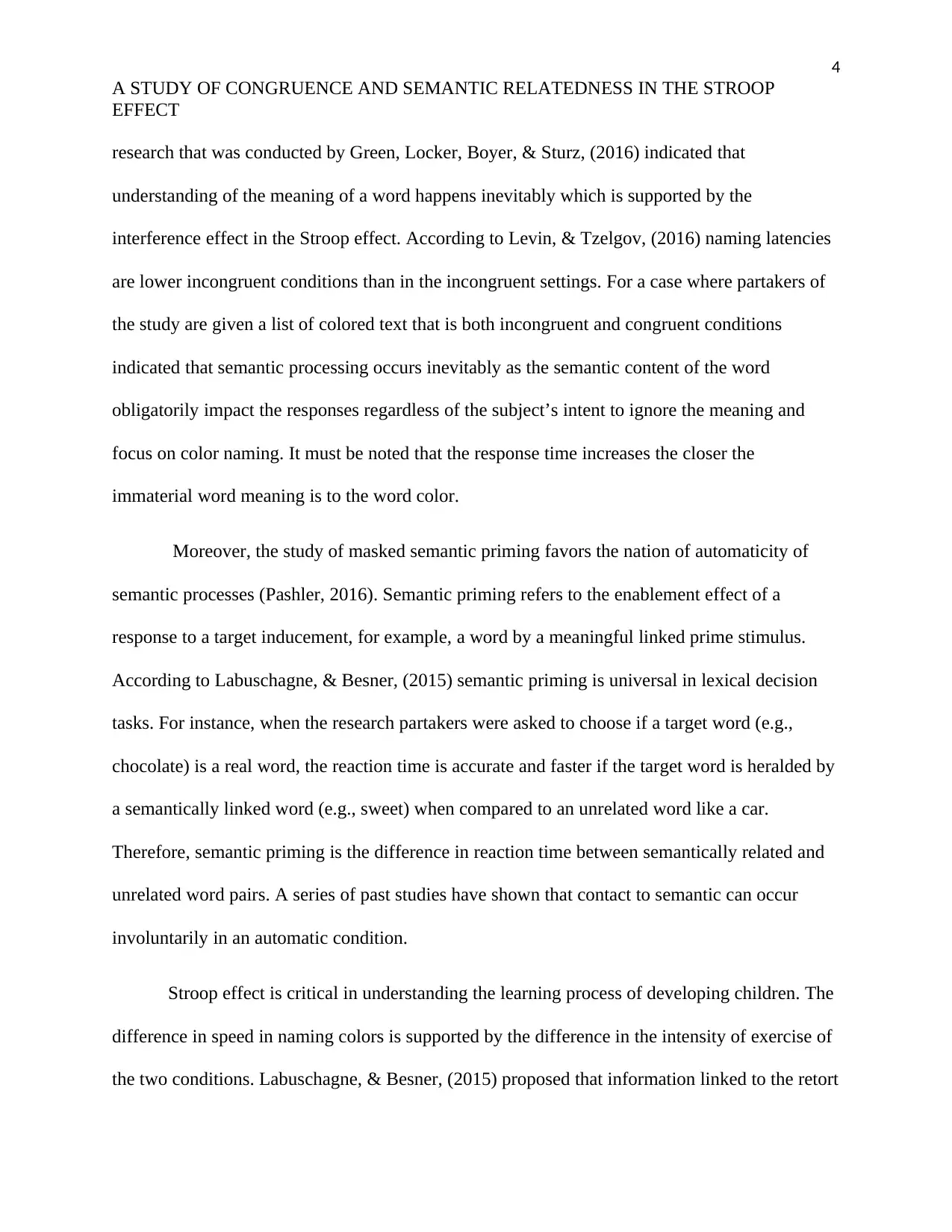
4
A STUDY OF CONGRUENCE AND SEMANTIC RELATEDNESS IN THE STROOP
EFFECT
research that was conducted by Green, Locker, Boyer, & Sturz, (2016) indicated that
understanding of the meaning of a word happens inevitably which is supported by the
interference effect in the Stroop effect. According to Levin, & Tzelgov, (2016) naming latencies
are lower incongruent conditions than in the incongruent settings. For a case where partakers of
the study are given a list of colored text that is both incongruent and congruent conditions
indicated that semantic processing occurs inevitably as the semantic content of the word
obligatorily impact the responses regardless of the subject’s intent to ignore the meaning and
focus on color naming. It must be noted that the response time increases the closer the
immaterial word meaning is to the word color.
Moreover, the study of masked semantic priming favors the nation of automaticity of
semantic processes (Pashler, 2016). Semantic priming refers to the enablement effect of a
response to a target inducement, for example, a word by a meaningful linked prime stimulus.
According to Labuschagne, & Besner, (2015) semantic priming is universal in lexical decision
tasks. For instance, when the research partakers were asked to choose if a target word (e.g.,
chocolate) is a real word, the reaction time is accurate and faster if the target word is heralded by
a semantically linked word (e.g., sweet) when compared to an unrelated word like a car.
Therefore, semantic priming is the difference in reaction time between semantically related and
unrelated word pairs. A series of past studies have shown that contact to semantic can occur
involuntarily in an automatic condition.
Stroop effect is critical in understanding the learning process of developing children. The
difference in speed in naming colors is supported by the difference in the intensity of exercise of
the two conditions. Labuschagne, & Besner, (2015) proposed that information linked to the retort
A STUDY OF CONGRUENCE AND SEMANTIC RELATEDNESS IN THE STROOP
EFFECT
research that was conducted by Green, Locker, Boyer, & Sturz, (2016) indicated that
understanding of the meaning of a word happens inevitably which is supported by the
interference effect in the Stroop effect. According to Levin, & Tzelgov, (2016) naming latencies
are lower incongruent conditions than in the incongruent settings. For a case where partakers of
the study are given a list of colored text that is both incongruent and congruent conditions
indicated that semantic processing occurs inevitably as the semantic content of the word
obligatorily impact the responses regardless of the subject’s intent to ignore the meaning and
focus on color naming. It must be noted that the response time increases the closer the
immaterial word meaning is to the word color.
Moreover, the study of masked semantic priming favors the nation of automaticity of
semantic processes (Pashler, 2016). Semantic priming refers to the enablement effect of a
response to a target inducement, for example, a word by a meaningful linked prime stimulus.
According to Labuschagne, & Besner, (2015) semantic priming is universal in lexical decision
tasks. For instance, when the research partakers were asked to choose if a target word (e.g.,
chocolate) is a real word, the reaction time is accurate and faster if the target word is heralded by
a semantically linked word (e.g., sweet) when compared to an unrelated word like a car.
Therefore, semantic priming is the difference in reaction time between semantically related and
unrelated word pairs. A series of past studies have shown that contact to semantic can occur
involuntarily in an automatic condition.
Stroop effect is critical in understanding the learning process of developing children. The
difference in speed in naming colors is supported by the difference in the intensity of exercise of
the two conditions. Labuschagne, & Besner, (2015) proposed that information linked to the retort
Paraphrase This Document
Need a fresh take? Get an instant paraphrase of this document with our AI Paraphraser
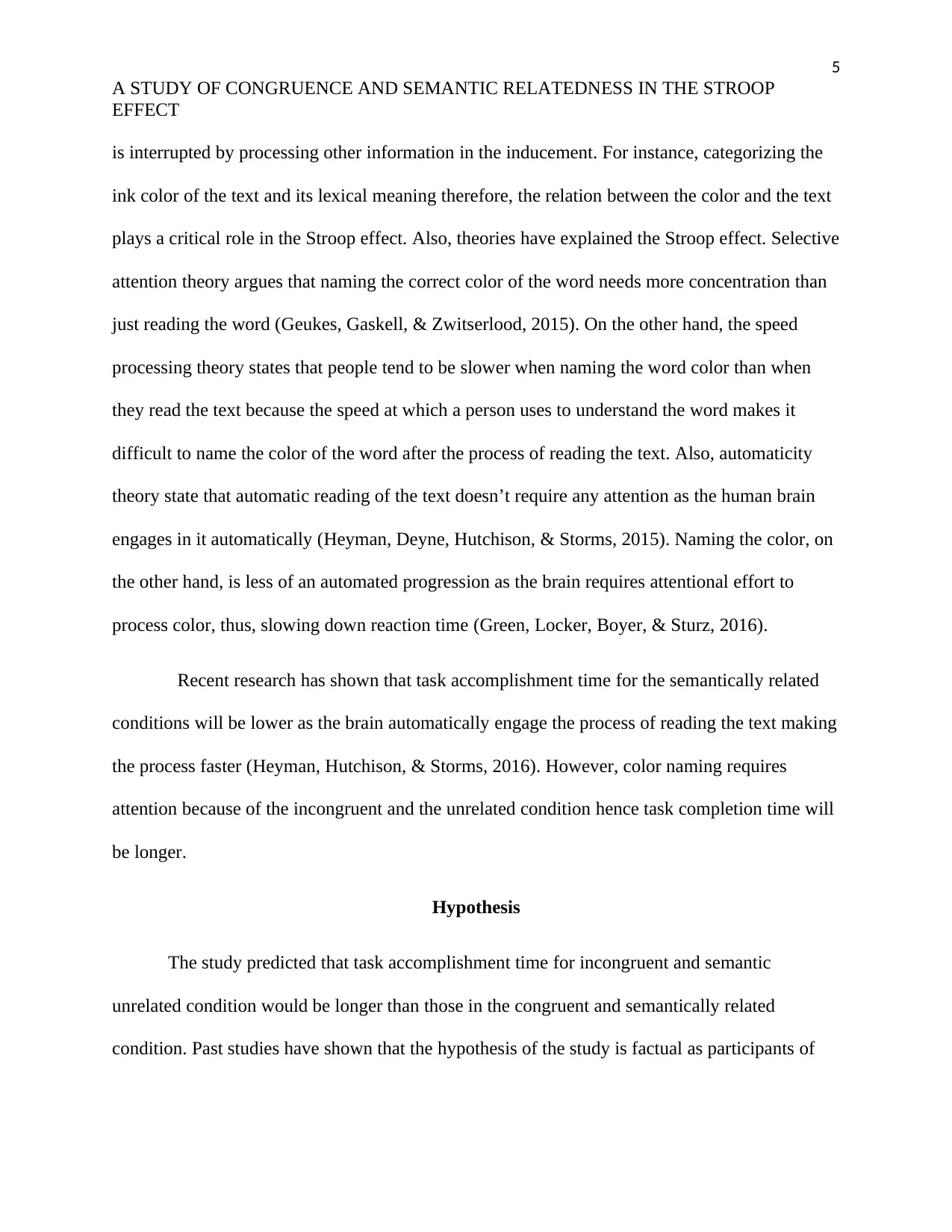
5
A STUDY OF CONGRUENCE AND SEMANTIC RELATEDNESS IN THE STROOP
EFFECT
is interrupted by processing other information in the inducement. For instance, categorizing the
ink color of the text and its lexical meaning therefore, the relation between the color and the text
plays a critical role in the Stroop effect. Also, theories have explained the Stroop effect. Selective
attention theory argues that naming the correct color of the word needs more concentration than
just reading the word (Geukes, Gaskell, & Zwitserlood, 2015). On the other hand, the speed
processing theory states that people tend to be slower when naming the word color than when
they read the text because the speed at which a person uses to understand the word makes it
difficult to name the color of the word after the process of reading the text. Also, automaticity
theory state that automatic reading of the text doesn’t require any attention as the human brain
engages in it automatically (Heyman, Deyne, Hutchison, & Storms, 2015). Naming the color, on
the other hand, is less of an automated progression as the brain requires attentional effort to
process color, thus, slowing down reaction time (Green, Locker, Boyer, & Sturz, 2016).
Recent research has shown that task accomplishment time for the semantically related
conditions will be lower as the brain automatically engage the process of reading the text making
the process faster (Heyman, Hutchison, & Storms, 2016). However, color naming requires
attention because of the incongruent and the unrelated condition hence task completion time will
be longer.
Hypothesis
The study predicted that task accomplishment time for incongruent and semantic
unrelated condition would be longer than those in the congruent and semantically related
condition. Past studies have shown that the hypothesis of the study is factual as participants of
A STUDY OF CONGRUENCE AND SEMANTIC RELATEDNESS IN THE STROOP
EFFECT
is interrupted by processing other information in the inducement. For instance, categorizing the
ink color of the text and its lexical meaning therefore, the relation between the color and the text
plays a critical role in the Stroop effect. Also, theories have explained the Stroop effect. Selective
attention theory argues that naming the correct color of the word needs more concentration than
just reading the word (Geukes, Gaskell, & Zwitserlood, 2015). On the other hand, the speed
processing theory states that people tend to be slower when naming the word color than when
they read the text because the speed at which a person uses to understand the word makes it
difficult to name the color of the word after the process of reading the text. Also, automaticity
theory state that automatic reading of the text doesn’t require any attention as the human brain
engages in it automatically (Heyman, Deyne, Hutchison, & Storms, 2015). Naming the color, on
the other hand, is less of an automated progression as the brain requires attentional effort to
process color, thus, slowing down reaction time (Green, Locker, Boyer, & Sturz, 2016).
Recent research has shown that task accomplishment time for the semantically related
conditions will be lower as the brain automatically engage the process of reading the text making
the process faster (Heyman, Hutchison, & Storms, 2016). However, color naming requires
attention because of the incongruent and the unrelated condition hence task completion time will
be longer.
Hypothesis
The study predicted that task accomplishment time for incongruent and semantic
unrelated condition would be longer than those in the congruent and semantically related
condition. Past studies have shown that the hypothesis of the study is factual as participants of
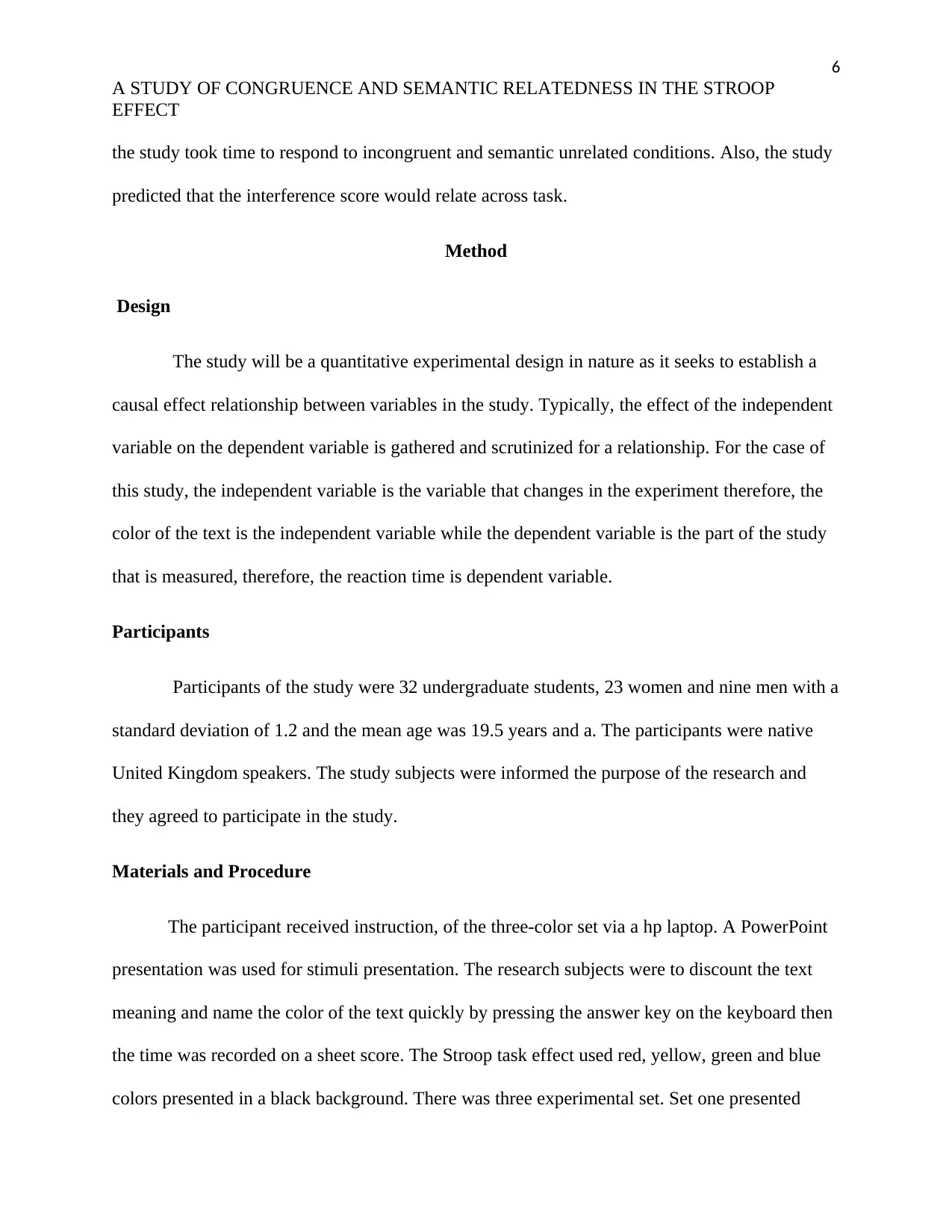
6
A STUDY OF CONGRUENCE AND SEMANTIC RELATEDNESS IN THE STROOP
EFFECT
the study took time to respond to incongruent and semantic unrelated conditions. Also, the study
predicted that the interference score would relate across task.
Method
Design
The study will be a quantitative experimental design in nature as it seeks to establish a
causal effect relationship between variables in the study. Typically, the effect of the independent
variable on the dependent variable is gathered and scrutinized for a relationship. For the case of
this study, the independent variable is the variable that changes in the experiment therefore, the
color of the text is the independent variable while the dependent variable is the part of the study
that is measured, therefore, the reaction time is dependent variable.
Participants
Participants of the study were 32 undergraduate students, 23 women and nine men with a
standard deviation of 1.2 and the mean age was 19.5 years and a. The participants were native
United Kingdom speakers. The study subjects were informed the purpose of the research and
they agreed to participate in the study.
Materials and Procedure
The participant received instruction, of the three-color set via a hp laptop. A PowerPoint
presentation was used for stimuli presentation. The research subjects were to discount the text
meaning and name the color of the text quickly by pressing the answer key on the keyboard then
the time was recorded on a sheet score. The Stroop task effect used red, yellow, green and blue
colors presented in a black background. There was three experimental set. Set one presented
A STUDY OF CONGRUENCE AND SEMANTIC RELATEDNESS IN THE STROOP
EFFECT
the study took time to respond to incongruent and semantic unrelated conditions. Also, the study
predicted that the interference score would relate across task.
Method
Design
The study will be a quantitative experimental design in nature as it seeks to establish a
causal effect relationship between variables in the study. Typically, the effect of the independent
variable on the dependent variable is gathered and scrutinized for a relationship. For the case of
this study, the independent variable is the variable that changes in the experiment therefore, the
color of the text is the independent variable while the dependent variable is the part of the study
that is measured, therefore, the reaction time is dependent variable.
Participants
Participants of the study were 32 undergraduate students, 23 women and nine men with a
standard deviation of 1.2 and the mean age was 19.5 years and a. The participants were native
United Kingdom speakers. The study subjects were informed the purpose of the research and
they agreed to participate in the study.
Materials and Procedure
The participant received instruction, of the three-color set via a hp laptop. A PowerPoint
presentation was used for stimuli presentation. The research subjects were to discount the text
meaning and name the color of the text quickly by pressing the answer key on the keyboard then
the time was recorded on a sheet score. The Stroop task effect used red, yellow, green and blue
colors presented in a black background. There was three experimental set. Set one presented
⊘ This is a preview!⊘
Do you want full access?
Subscribe today to unlock all pages.

Trusted by 1+ million students worldwide
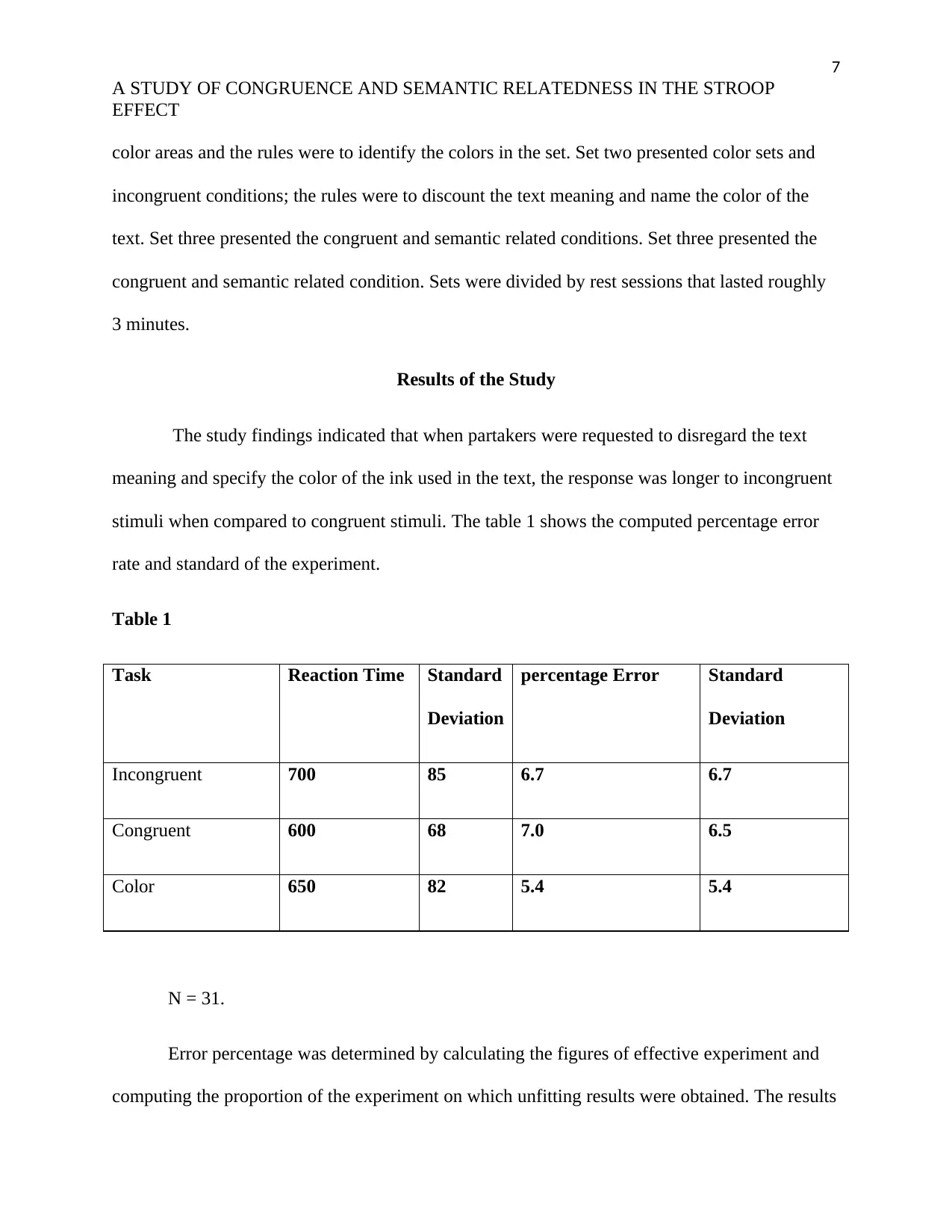
7
A STUDY OF CONGRUENCE AND SEMANTIC RELATEDNESS IN THE STROOP
EFFECT
color areas and the rules were to identify the colors in the set. Set two presented color sets and
incongruent conditions; the rules were to discount the text meaning and name the color of the
text. Set three presented the congruent and semantic related conditions. Set three presented the
congruent and semantic related condition. Sets were divided by rest sessions that lasted roughly
3 minutes.
Results of the Study
The study findings indicated that when partakers were requested to disregard the text
meaning and specify the color of the ink used in the text, the response was longer to incongruent
stimuli when compared to congruent stimuli. The table 1 shows the computed percentage error
rate and standard of the experiment.
Table 1
Task Reaction Time Standard
Deviation
percentage Error Standard
Deviation
Incongruent 700 85 6.7 6.7
Congruent 600 68 7.0 6.5
Color 650 82 5.4 5.4
N = 31.
Error percentage was determined by calculating the figures of effective experiment and
computing the proportion of the experiment on which unfitting results were obtained. The results
A STUDY OF CONGRUENCE AND SEMANTIC RELATEDNESS IN THE STROOP
EFFECT
color areas and the rules were to identify the colors in the set. Set two presented color sets and
incongruent conditions; the rules were to discount the text meaning and name the color of the
text. Set three presented the congruent and semantic related conditions. Set three presented the
congruent and semantic related condition. Sets were divided by rest sessions that lasted roughly
3 minutes.
Results of the Study
The study findings indicated that when partakers were requested to disregard the text
meaning and specify the color of the ink used in the text, the response was longer to incongruent
stimuli when compared to congruent stimuli. The table 1 shows the computed percentage error
rate and standard of the experiment.
Table 1
Task Reaction Time Standard
Deviation
percentage Error Standard
Deviation
Incongruent 700 85 6.7 6.7
Congruent 600 68 7.0 6.5
Color 650 82 5.4 5.4
N = 31.
Error percentage was determined by calculating the figures of effective experiment and
computing the proportion of the experiment on which unfitting results were obtained. The results
Paraphrase This Document
Need a fresh take? Get an instant paraphrase of this document with our AI Paraphraser
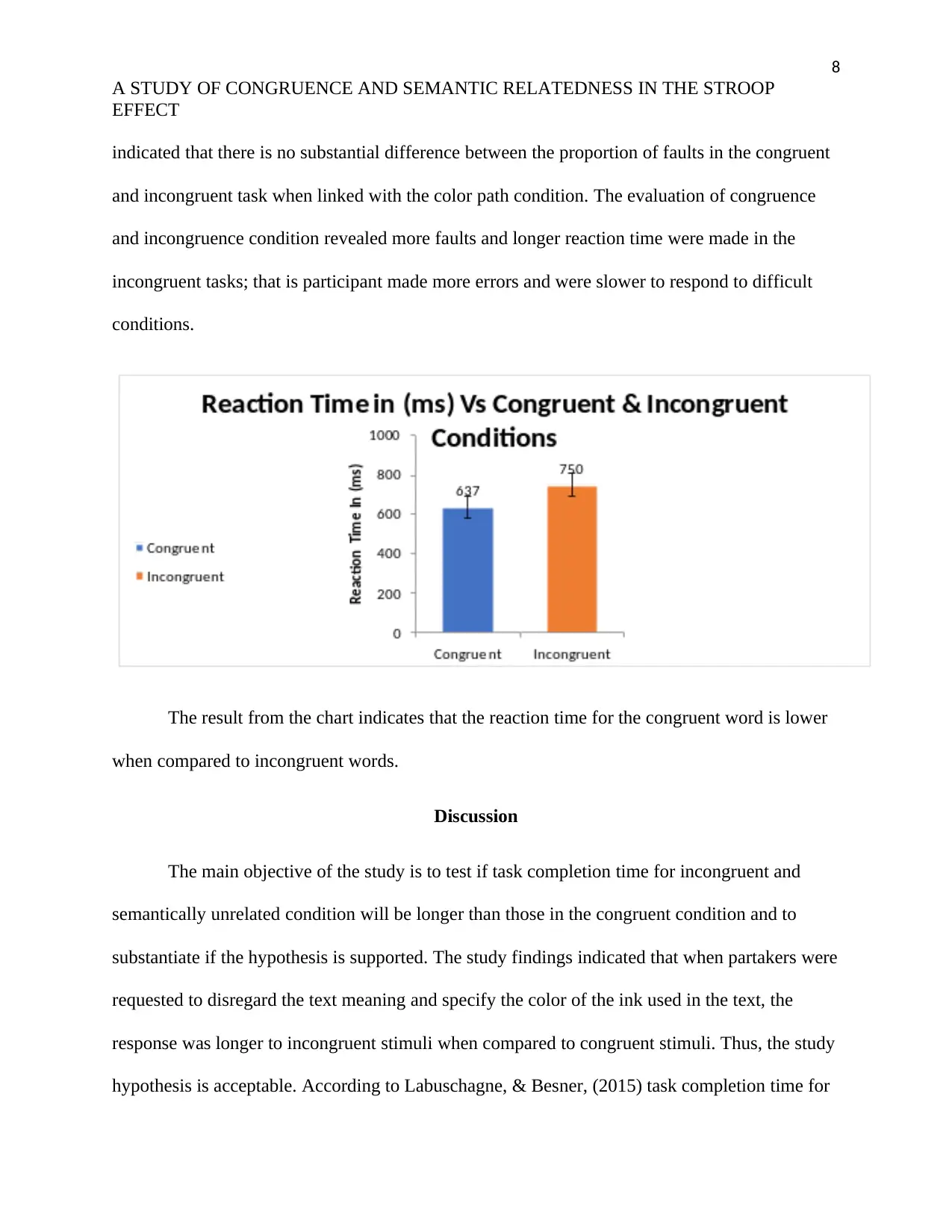
8
A STUDY OF CONGRUENCE AND SEMANTIC RELATEDNESS IN THE STROOP
EFFECT
indicated that there is no substantial difference between the proportion of faults in the congruent
and incongruent task when linked with the color path condition. The evaluation of congruence
and incongruence condition revealed more faults and longer reaction time were made in the
incongruent tasks; that is participant made more errors and were slower to respond to difficult
conditions.
The result from the chart indicates that the reaction time for the congruent word is lower
when compared to incongruent words.
Discussion
The main objective of the study is to test if task completion time for incongruent and
semantically unrelated condition will be longer than those in the congruent condition and to
substantiate if the hypothesis is supported. The study findings indicated that when partakers were
requested to disregard the text meaning and specify the color of the ink used in the text, the
response was longer to incongruent stimuli when compared to congruent stimuli. Thus, the study
hypothesis is acceptable. According to Labuschagne, & Besner, (2015) task completion time for
A STUDY OF CONGRUENCE AND SEMANTIC RELATEDNESS IN THE STROOP
EFFECT
indicated that there is no substantial difference between the proportion of faults in the congruent
and incongruent task when linked with the color path condition. The evaluation of congruence
and incongruence condition revealed more faults and longer reaction time were made in the
incongruent tasks; that is participant made more errors and were slower to respond to difficult
conditions.
The result from the chart indicates that the reaction time for the congruent word is lower
when compared to incongruent words.
Discussion
The main objective of the study is to test if task completion time for incongruent and
semantically unrelated condition will be longer than those in the congruent condition and to
substantiate if the hypothesis is supported. The study findings indicated that when partakers were
requested to disregard the text meaning and specify the color of the ink used in the text, the
response was longer to incongruent stimuli when compared to congruent stimuli. Thus, the study
hypothesis is acceptable. According to Labuschagne, & Besner, (2015) task completion time for
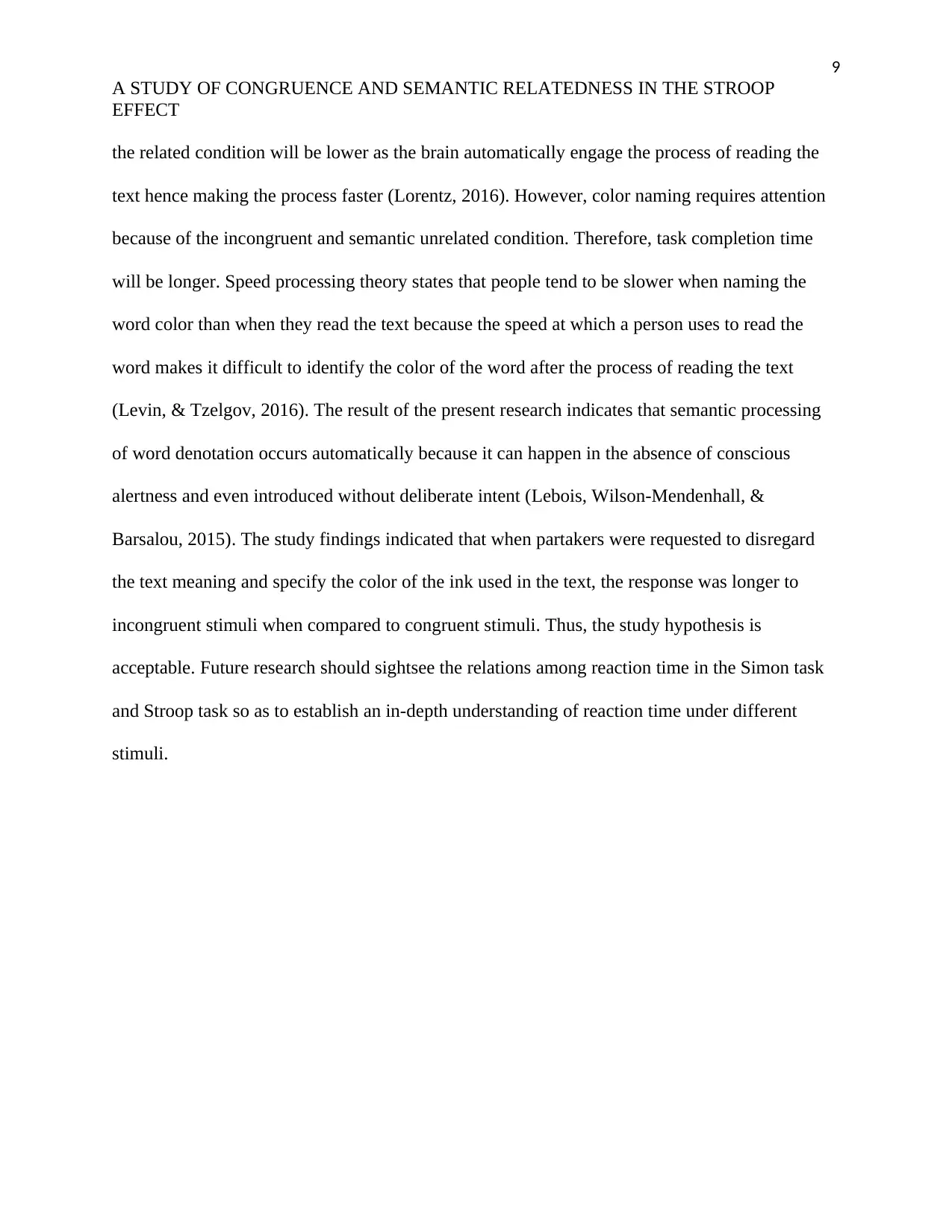
9
A STUDY OF CONGRUENCE AND SEMANTIC RELATEDNESS IN THE STROOP
EFFECT
the related condition will be lower as the brain automatically engage the process of reading the
text hence making the process faster (Lorentz, 2016). However, color naming requires attention
because of the incongruent and semantic unrelated condition. Therefore, task completion time
will be longer. Speed processing theory states that people tend to be slower when naming the
word color than when they read the text because the speed at which a person uses to read the
word makes it difficult to identify the color of the word after the process of reading the text
(Levin, & Tzelgov, 2016). The result of the present research indicates that semantic processing
of word denotation occurs automatically because it can happen in the absence of conscious
alertness and even introduced without deliberate intent (Lebois, Wilson‐Mendenhall, &
Barsalou, 2015). The study findings indicated that when partakers were requested to disregard
the text meaning and specify the color of the ink used in the text, the response was longer to
incongruent stimuli when compared to congruent stimuli. Thus, the study hypothesis is
acceptable. Future research should sightsee the relations among reaction time in the Simon task
and Stroop task so as to establish an in-depth understanding of reaction time under different
stimuli.
A STUDY OF CONGRUENCE AND SEMANTIC RELATEDNESS IN THE STROOP
EFFECT
the related condition will be lower as the brain automatically engage the process of reading the
text hence making the process faster (Lorentz, 2016). However, color naming requires attention
because of the incongruent and semantic unrelated condition. Therefore, task completion time
will be longer. Speed processing theory states that people tend to be slower when naming the
word color than when they read the text because the speed at which a person uses to read the
word makes it difficult to identify the color of the word after the process of reading the text
(Levin, & Tzelgov, 2016). The result of the present research indicates that semantic processing
of word denotation occurs automatically because it can happen in the absence of conscious
alertness and even introduced without deliberate intent (Lebois, Wilson‐Mendenhall, &
Barsalou, 2015). The study findings indicated that when partakers were requested to disregard
the text meaning and specify the color of the ink used in the text, the response was longer to
incongruent stimuli when compared to congruent stimuli. Thus, the study hypothesis is
acceptable. Future research should sightsee the relations among reaction time in the Simon task
and Stroop task so as to establish an in-depth understanding of reaction time under different
stimuli.
⊘ This is a preview!⊘
Do you want full access?
Subscribe today to unlock all pages.

Trusted by 1+ million students worldwide
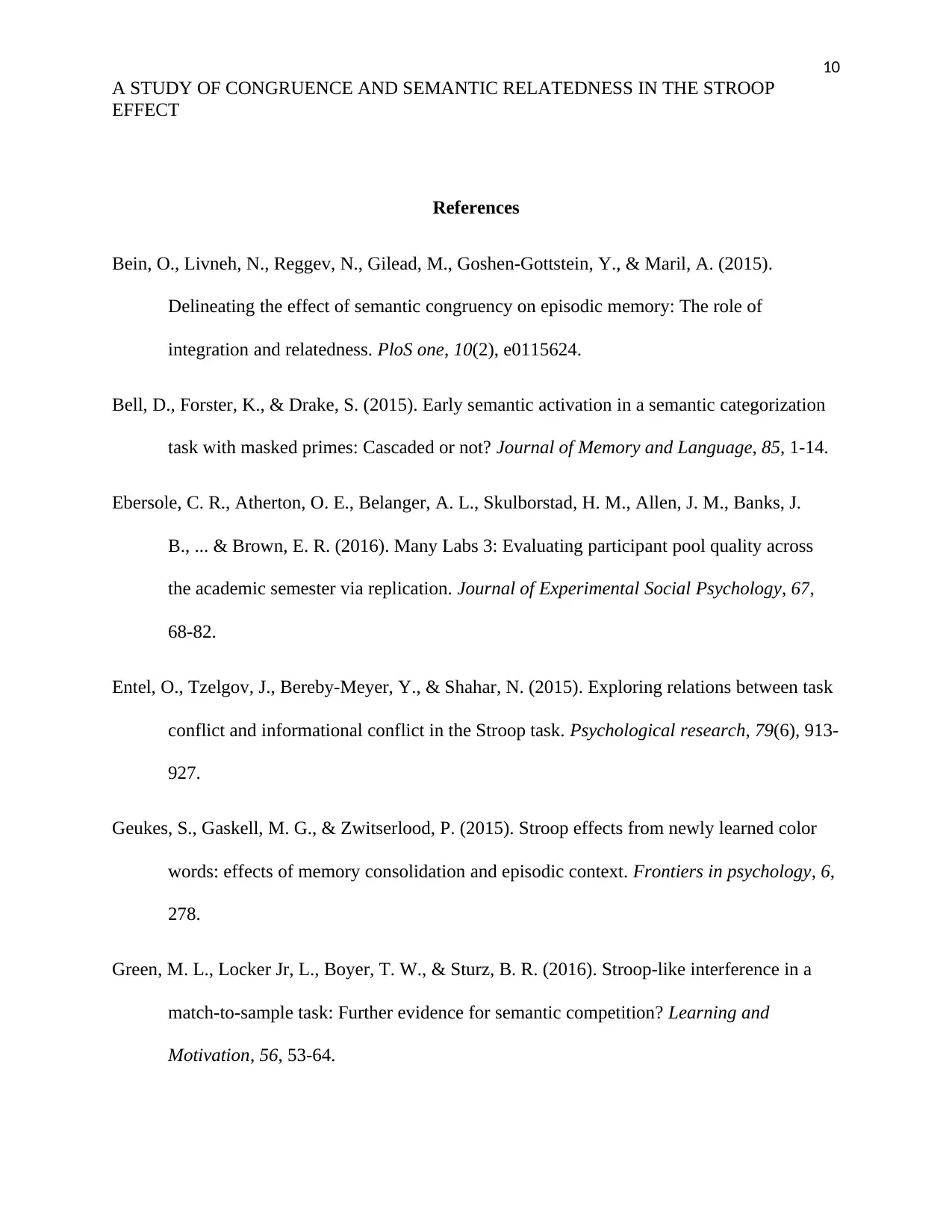
10
A STUDY OF CONGRUENCE AND SEMANTIC RELATEDNESS IN THE STROOP
EFFECT
References
Bein, O., Livneh, N., Reggev, N., Gilead, M., Goshen-Gottstein, Y., & Maril, A. (2015).
Delineating the effect of semantic congruency on episodic memory: The role of
integration and relatedness. PloS one, 10(2), e0115624.
Bell, D., Forster, K., & Drake, S. (2015). Early semantic activation in a semantic categorization
task with masked primes: Cascaded or not? Journal of Memory and Language, 85, 1-14.
Ebersole, C. R., Atherton, O. E., Belanger, A. L., Skulborstad, H. M., Allen, J. M., Banks, J.
B., ... & Brown, E. R. (2016). Many Labs 3: Evaluating participant pool quality across
the academic semester via replication. Journal of Experimental Social Psychology, 67,
68-82.
Entel, O., Tzelgov, J., Bereby-Meyer, Y., & Shahar, N. (2015). Exploring relations between task
conflict and informational conflict in the Stroop task. Psychological research, 79(6), 913-
927.
Geukes, S., Gaskell, M. G., & Zwitserlood, P. (2015). Stroop effects from newly learned color
words: effects of memory consolidation and episodic context. Frontiers in psychology, 6,
278.
Green, M. L., Locker Jr, L., Boyer, T. W., & Sturz, B. R. (2016). Stroop-like interference in a
match-to-sample task: Further evidence for semantic competition? Learning and
Motivation, 56, 53-64.
A STUDY OF CONGRUENCE AND SEMANTIC RELATEDNESS IN THE STROOP
EFFECT
References
Bein, O., Livneh, N., Reggev, N., Gilead, M., Goshen-Gottstein, Y., & Maril, A. (2015).
Delineating the effect of semantic congruency on episodic memory: The role of
integration and relatedness. PloS one, 10(2), e0115624.
Bell, D., Forster, K., & Drake, S. (2015). Early semantic activation in a semantic categorization
task with masked primes: Cascaded or not? Journal of Memory and Language, 85, 1-14.
Ebersole, C. R., Atherton, O. E., Belanger, A. L., Skulborstad, H. M., Allen, J. M., Banks, J.
B., ... & Brown, E. R. (2016). Many Labs 3: Evaluating participant pool quality across
the academic semester via replication. Journal of Experimental Social Psychology, 67,
68-82.
Entel, O., Tzelgov, J., Bereby-Meyer, Y., & Shahar, N. (2015). Exploring relations between task
conflict and informational conflict in the Stroop task. Psychological research, 79(6), 913-
927.
Geukes, S., Gaskell, M. G., & Zwitserlood, P. (2015). Stroop effects from newly learned color
words: effects of memory consolidation and episodic context. Frontiers in psychology, 6,
278.
Green, M. L., Locker Jr, L., Boyer, T. W., & Sturz, B. R. (2016). Stroop-like interference in a
match-to-sample task: Further evidence for semantic competition? Learning and
Motivation, 56, 53-64.
Paraphrase This Document
Need a fresh take? Get an instant paraphrase of this document with our AI Paraphraser
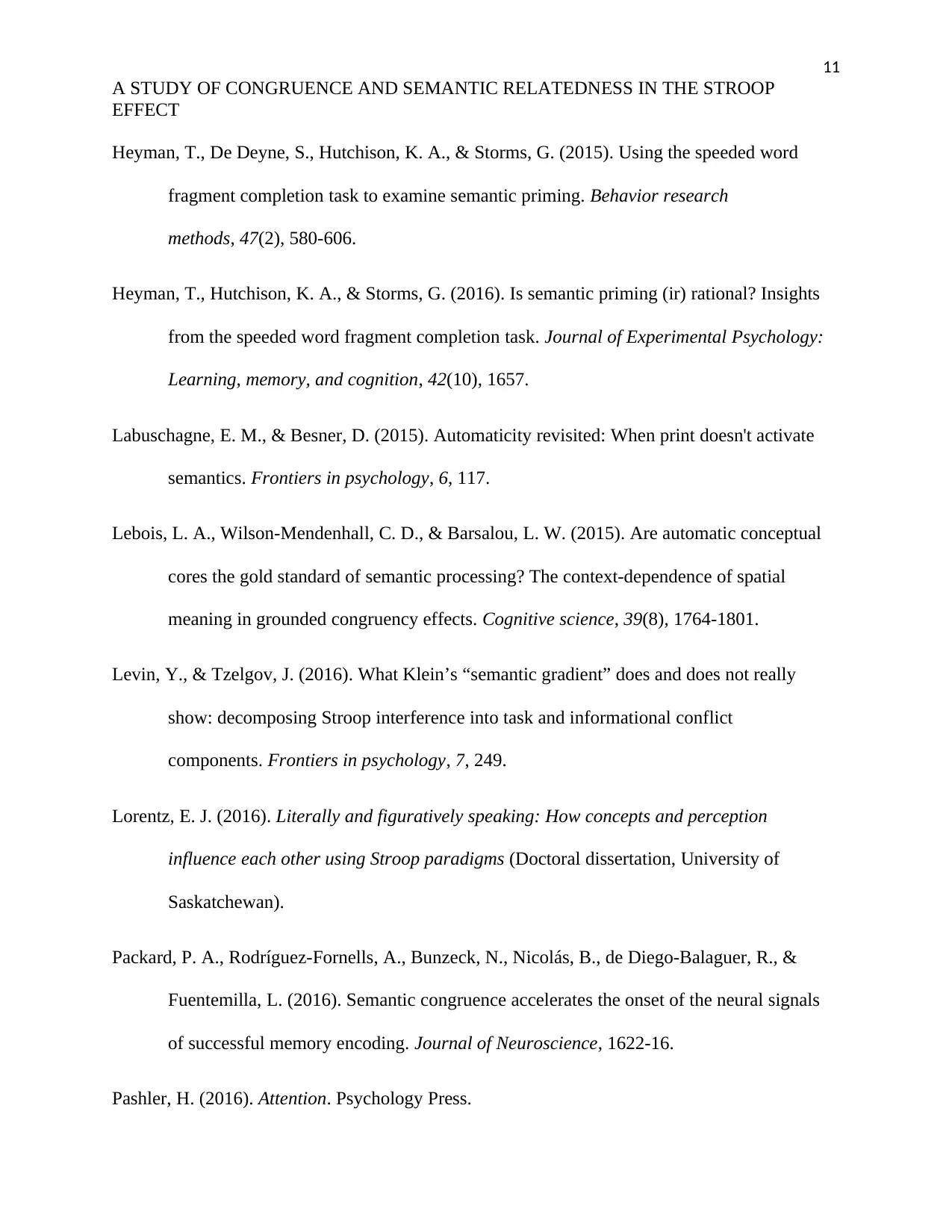
11
A STUDY OF CONGRUENCE AND SEMANTIC RELATEDNESS IN THE STROOP
EFFECT
Heyman, T., De Deyne, S., Hutchison, K. A., & Storms, G. (2015). Using the speeded word
fragment completion task to examine semantic priming. Behavior research
methods, 47(2), 580-606.
Heyman, T., Hutchison, K. A., & Storms, G. (2016). Is semantic priming (ir) rational? Insights
from the speeded word fragment completion task. Journal of Experimental Psychology:
Learning, memory, and cognition, 42(10), 1657.
Labuschagne, E. M., & Besner, D. (2015). Automaticity revisited: When print doesn't activate
semantics. Frontiers in psychology, 6, 117.
Lebois, L. A., Wilson‐Mendenhall, C. D., & Barsalou, L. W. (2015). Are automatic conceptual
cores the gold standard of semantic processing? The context‐dependence of spatial
meaning in grounded congruency effects. Cognitive science, 39(8), 1764-1801.
Levin, Y., & Tzelgov, J. (2016). What Klein’s “semantic gradient” does and does not really
show: decomposing Stroop interference into task and informational conflict
components. Frontiers in psychology, 7, 249.
Lorentz, E. J. (2016). Literally and figuratively speaking: How concepts and perception
influence each other using Stroop paradigms (Doctoral dissertation, University of
Saskatchewan).
Packard, P. A., Rodríguez-Fornells, A., Bunzeck, N., Nicolás, B., de Diego-Balaguer, R., &
Fuentemilla, L. (2016). Semantic congruence accelerates the onset of the neural signals
of successful memory encoding. Journal of Neuroscience, 1622-16.
Pashler, H. (2016). Attention. Psychology Press.
A STUDY OF CONGRUENCE AND SEMANTIC RELATEDNESS IN THE STROOP
EFFECT
Heyman, T., De Deyne, S., Hutchison, K. A., & Storms, G. (2015). Using the speeded word
fragment completion task to examine semantic priming. Behavior research
methods, 47(2), 580-606.
Heyman, T., Hutchison, K. A., & Storms, G. (2016). Is semantic priming (ir) rational? Insights
from the speeded word fragment completion task. Journal of Experimental Psychology:
Learning, memory, and cognition, 42(10), 1657.
Labuschagne, E. M., & Besner, D. (2015). Automaticity revisited: When print doesn't activate
semantics. Frontiers in psychology, 6, 117.
Lebois, L. A., Wilson‐Mendenhall, C. D., & Barsalou, L. W. (2015). Are automatic conceptual
cores the gold standard of semantic processing? The context‐dependence of spatial
meaning in grounded congruency effects. Cognitive science, 39(8), 1764-1801.
Levin, Y., & Tzelgov, J. (2016). What Klein’s “semantic gradient” does and does not really
show: decomposing Stroop interference into task and informational conflict
components. Frontiers in psychology, 7, 249.
Lorentz, E. J. (2016). Literally and figuratively speaking: How concepts and perception
influence each other using Stroop paradigms (Doctoral dissertation, University of
Saskatchewan).
Packard, P. A., Rodríguez-Fornells, A., Bunzeck, N., Nicolás, B., de Diego-Balaguer, R., &
Fuentemilla, L. (2016). Semantic congruence accelerates the onset of the neural signals
of successful memory encoding. Journal of Neuroscience, 1622-16.
Pashler, H. (2016). Attention. Psychology Press.
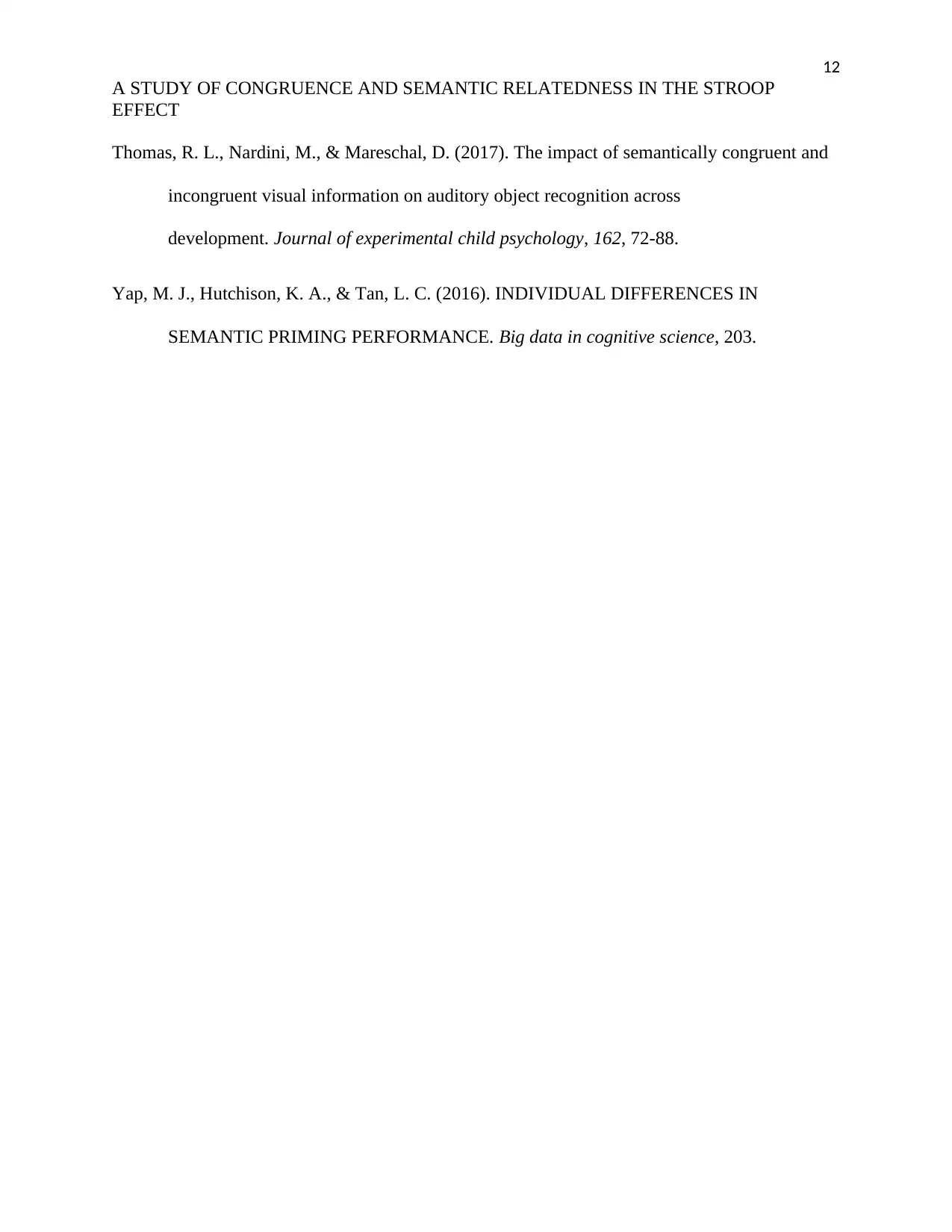
12
A STUDY OF CONGRUENCE AND SEMANTIC RELATEDNESS IN THE STROOP
EFFECT
Thomas, R. L., Nardini, M., & Mareschal, D. (2017). The impact of semantically congruent and
incongruent visual information on auditory object recognition across
development. Journal of experimental child psychology, 162, 72-88.
Yap, M. J., Hutchison, K. A., & Tan, L. C. (2016). INDIVIDUAL DIFFERENCES IN
SEMANTIC PRIMING PERFORMANCE. Big data in cognitive science, 203.
A STUDY OF CONGRUENCE AND SEMANTIC RELATEDNESS IN THE STROOP
EFFECT
Thomas, R. L., Nardini, M., & Mareschal, D. (2017). The impact of semantically congruent and
incongruent visual information on auditory object recognition across
development. Journal of experimental child psychology, 162, 72-88.
Yap, M. J., Hutchison, K. A., & Tan, L. C. (2016). INDIVIDUAL DIFFERENCES IN
SEMANTIC PRIMING PERFORMANCE. Big data in cognitive science, 203.
⊘ This is a preview!⊘
Do you want full access?
Subscribe today to unlock all pages.

Trusted by 1+ million students worldwide
1 out of 12
Related Documents
Your All-in-One AI-Powered Toolkit for Academic Success.
+13062052269
info@desklib.com
Available 24*7 on WhatsApp / Email
![[object Object]](/_next/static/media/star-bottom.7253800d.svg)
Unlock your academic potential
Copyright © 2020–2025 A2Z Services. All Rights Reserved. Developed and managed by ZUCOL.




